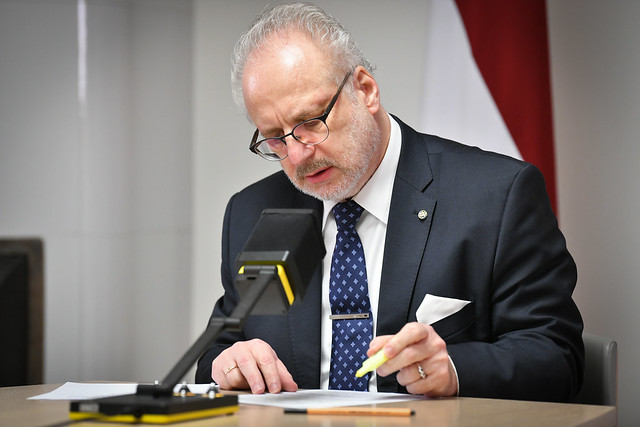Congratulations everyone on the 24th Anniversary of the Constitutional Court!
As Madam Osipova already mentioned, Constitutional Court and the rule of law were some of the main demands that people made during the Awakening. The idea of establishing a Constitutional Court was first presented at one of the Latvian Science Academy meetings in 1988 when I suggested to create such constitutional institution. Then it was included in the text of the Declaration adopted on 4 May 1990, and it took another six years for this idea to become a reality. Next year Constitutional Court will celebrate its milestone anniversary and hopefully we will be able to mark the occasion by coming together for this wonderful celebration.
I
Let me start by making a short comment about the topic of today’s forum – use of Constitutional Court case law to adopt new legal acts. Let me briefly focus on President’s mandate in this regard and then I will switch to challenges in implementation of Constitutional Court judgements, followed by some of the ideas on how to create a framework for more efficient enforcement of these decisions.
As far as President’s mandate is concerned, I believe there are three ways in which President can facilitate implementation of Court decisions. First, there is an option that is rarely associated with implementation or enforcement of Constitutional Court judgements. I am talking about President’s right to request the parliament to reconsider a law. In other words, Constitutional Court decisions become relevant in specific cases that involve laws adopted by the parliament and returned to the parliament for further consideration by the President because they contradict specific findings or conclusions of Constitutional Court. This gives President the right to return a law to the parliament for reconsideration with expressis verbis note indicating which judgement of the Constitutional Court has been omitted by the Saeima when passing a law.
Then there is also the proactive approach. President can make a claim to the Court. So far there have been very few cases when President has resorted to this option, but it does exist nevertheless, and if there is a need to invoke it, and this constitutional mechanism needs to be triggered, President has all the rights to do so.
And lastly, President can also be proactive and take active role in dialogue between constitutional institutions (President and Saeima or President and Cabinet of Ministers if it concerns secondary legislation proposed by Cabinet). As you know, each President has his or her own style of working. I am very keen on using this option and have resorted to it on many occasions either by making formal comments and sending letters or informally expressing my views at various meetings with officials and MPs that shape our policies. In other words, I have contributed my opinion in the process of making new laws and my views have been largely respected in terms of the end result. The benefits of such approach are: no need for returning a law for reconsideration and parliament being given clear indication of what the proposed law should look like right from the get-go. And President, of course, can refer to specific Constitutional Court judgements in his opinion or recommendations on what needs to be considered when drafting a particular law.
So, as I just described, President has three options: return a law to parliament, make a claim to Constitutional Court and engage in constitutional dialogue with Saeima and/or Cabinet of Ministers.
II
Let me now briefly talk about problems in application of past Constitutional Court judgements. To me there are four kinds of such problems. Constitutional Court may give legislature some time to prepare for enforcement of its judgements. Back in the day I was one of those who heavily advocated for such arrangement and we managed to get it set down in the Constitutional Court Law. Not all constitutional courts offer such possibility. For instance, Austria has it, while Germany does not. I believe this is a very good way to create an efficient working relationship between the two constitutional bodies – the Constitutional Court and the Saeima. But problems tend to arise once the transition deadline is over and there is no clear understanding of what to do next. We do not have the solution for that just yet. It is still one of the challenges that we have to deal with – what to do when judgement of the Court has not been enforced and there are no legal ways to force compliance.
Another problem is that a proper enforcement of a judgement may require changes in several laws at once, when the whole approach needs to be reviewed, i.e. we need to rethink specific concepts that underpin a number of laws or revisit embedded notions that underlie various policy approaches. To change concepts that have legal and political implications or quite often political and even more often extra-political implications all at once (like, for example, concept of family), we need to amend a whole host of laws and we need to develop a purposeful and meaningful approach to these new, universally applicable concepts. That requires time and quite often apart from parliamentary debate also a public debate is required to reach a better understanding and support for these new concepts. This route is a lot harder to take, but it certainly is the only way to ensure compliance with Court judgements.
Third, legislature must be ready to engage in this legal and political dialogue with the Constitutional Court. In other words, if legislature insists on minor tweaks to the law that do not meet the criteria established by the Court in its judgement or decides to introduce other legal mechanisms achieving the same outcomes, Saeima can enforce the judgement of the Constitutional Court by making the relevant law or changes therein, or even changing the Constitution as necessary. That is how it engages in constitutional dialogue. And Constitutional Court, of course, may respond to such actions in such constitutional dialogue as it sees fit.
Another quite significant challenge is lack of coordination in enforcement of Court rulings. Line ministries mostly have very little influence on how fast the wheels of legislature turn. For example, ministry might become aware of the need to change a particular law, but parliament might not be ready to react. So, ministries have little influence over agenda of the parliament and how quickly it responds to legislative requests of ministries. That is how parliamentary autonomy is ensured.
One of the possible solutions here could be restoring a mechanism that already existed until not so long ago – Cabinet of Ministers secretary who would work at the Constitutional Court. It was an efficient tool, which was cut during the 2008/2009 crisis when public administration was downsized. But it was very efficient. There was always an official who would keep an eye on practical implementation and act as a kind of whip, ensuring this kind of discipline among MPs or Cabinet members. I think it was a very good mechanism and we should bring it back. This role is currently partly played by Legal Bureau of the Saeima. However, its reach does not really extend to Cabinet of Ministers. This mechanism would, of course, not be a silver bullet, but it would definitely be an efficient way to sort these challenges out and establish an efficient mechanism for implementation and enforcement of Constitutional Court judgements.
Thank you! I am very much looking forward to an interesting discussion here today.





